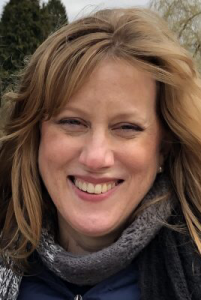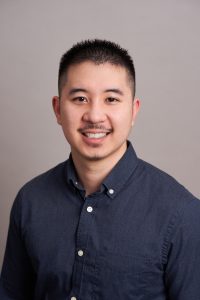
Thursday, September 29 | 1:00PM – 2:00PM
Panelists:

Dr. Joanna Cannon, Professor, Educational & Counselling Psychology, & Special Education
Dr. Joanna E. Cannon is a Professor in the Educational and Counselling Psychology and Special Education department at the University of British Columbia in Vancouver. She completed her Ph.D. after teaching deaf and hard of hearing students in middle school as an itinerant and resource teacher for 9 years. She is also the parent of an adult who is deaf with disabilities. Dr. Cannon is the coordinator of the Education of the Deaf and Hard of Hearing online Graduate Program concentration in the Special Education Area where she teaches the language, literacy, and curriculum courses. Her areas of research include grammar and literacy acquisition for students who are deaf and hard of hearing.

Eric Chau, Occupational Therapist, Neil Squire Society
Eric Chau is an Occupational Therapist and Certified Work/Functional Capacity Evaluator. He received his Bachelor of Kinesiology and Master of Occupational Therapy degrees from UBC. His current clinical work at Neil Squire Society focuses on addressing accessibility barriers encountered by individuals in the workplace and classroom through assistive technology and ergonomic solutions.
Facilitator:
Gabrielle Coombs, Learning Designer, ETS
Summary
Estimated reading time: 10 minutes
In the Viewpoints session “Technology and Accessible Learning: Adaptation, Augmentation, and Invention”, we explored the intersection of disability and technology. We welcomed our panelists Dr. Joanna Cannon, Adjunct Professor, ECPS, and Eric Chau, Occupational Therapist with the Neil Squire Society, a national non-profit organization.
Opening remarks
Dr. Joanna Cannon
Dr. Cannon started our conversation by discussing her area of expertise in special education related to deafness, and how a move to online education has provided a more accessible space for new teacher candidates to be trained in working with and teaching deaf or hard of hearing students.
Dr. Cannon went on to mention how she uses Universal Design for Learning (UDL) principles in developing courses, not only for those who are deaf or hard of hearing, but for all students. She discussed the value of providing multiple means of representation of content (as per the CAST UDL Guidelines):
“I know in in my field making things visual is very important, right. So I want a lot of visual aspects on my course modules, whether those be videos that they’re going to go access or Powerpoint slides that I have graphics in, but really stopping and thinking very carefully about how I represent the content online in that organizational format… for our students at university level that might have disabilities… [and for] students that don’t, because that’s just good teaching practice for everyone, but also to model what they should be doing with their students in their classroom right when they become teachers themselves”
She expanded on the other UDL principles of multiple means of action and expression and how these help teachers broaden their own perspectives on modalities that can be used for activities and assignments, providing students with more opportunities for artistic or creative expressions of their learning:
“Are we giving them different forms of expression? Are we allowing them to write? Obviously in print-based format. But to do a video of themselves to act something out um in an artistic and expressive way, or to actually make a piece of art, and have that represent their concepts within an assignment.”
Dr. Cannon also shared some of the ways she is working with UBC’s Centre for Accessibility to expand course contents to be more accessible for deaf and hard of hearing university students by recording American Sign Language (ASL) interpretations of audio and video content so those students can access their course materials in their first language.
Eric Chau
Eric Chau focused on the role that ergonomics and assistive technologies play in creating accessible learning for individuals with disabilities. He explained the considerations that he takes when exploring accessibility options and adjustments for clients.
“One of the more simplified models that are a bit more easily conceptualized is the person-environment-occupation model. So we’re sort of looking at the bi-directional intersection between these three points that that essentially dictates someone’s ability to participate and engage in any kind of activity.”
Eric Chau went onto explain that this model looks at a person’s strengths and abilities, and their limitations and disabilities, the physical or virtual environment and the demands, frequency and duration of the occupation (activity) in order to identify barriers and provide adjustments. Eric mentioned some common barriers for people can be inaccessible and difficult to read course materials, issues with following along and taking notes in synchronous classes, and issues with prolonged reading and computer work. In considering this, Eric continued by highlighting the assistive technologies and ergonomic adjustments that can be made for people with disabilities in an academic context: screen readers, audio pens, dictation technologies and captioning and transcription services, and then adjusted keyboards, mice, desks and monitors.
“When we’re looking at accessibility from a clinical perspective… we identify what the barriers are to accessible learning and then look at assistive technology, hardware, software and ergonomic equipment to overcome those barriers. And we also look at the accommodations and resources and support that are available in the community”
Eric Chau also highlighted that there are institutional resources and external bodies available for students to seek assistance with accessibility challenges. At UBC, we have the Centre for Accessibility.
Discussion themes
Participants in our discussion agreed that the move to online, whether from the pandemic or otherwise, has made learning opportunities accessible for a greater number of people. The panelists recognized that there are a lot of barriers to people accessing education, so online modalities present learning opportunities for people with disabilities, but also for remote learners, and non-traditional students.
However, a participant asked if technology can hinder access to learning. Eric Chau argued that when we rely too heavily on technology, we run the risk of that technology malfunctioning or not working as intended. Technologies and software also incur a cost, so for students who have older devices, limited bandwidth, or limited access to software because of cost or location, we can inadvertently exclude these learners. Dr. Cannon added that it is important that we aim for balance, as using too many technologies or tools can cause cognitive overload for students; there is typically a learning curve when introducing new technologies or tools which can detract from the overall learning experience. This can leave instructors in a position where they spend time troubleshooting technical glitches that could be used for course content.
Universal Design for Learning was brought up frequently throughout the discussion as guiding principles for both face-to-face and online learning. These principles (multiple means of engagement, representation, and action and expression) are a great starting place for building course materials, and are recognized to be a part of good teaching practice. Dr. Cannon shared a Table of UDL Principles and Guidelines With Examples (Guardino, Cannon, & Paul, 2022) which puts UDL into practice.
However, the conversation did lead to a critique of UDL, in that it does not address all needs, as both Dr. Cannon and Eric Chau noted. Further accommodations will be needed for some students, especially when making individualized accommodations such as providing assistive hardware or ASL interpretation. While following UDL means that fewer accommodations will need to made, it is not an outright replacement for accommodations.
Good accessibility technologies can be expensive. Both panelists frequently mentioned the cost of accommodations, and how accessing some accommodations such as ASL interpretation, accessibility software and ergonomic hardware are often out of reach for instructors and students alike because of how expensive they can be.
This highlights importance to good accessible practice from the beginning of course design. By creating accessible courses using UDL guidelines, fewer changes and accommodations will need to be made, hopefully leaving resources for more accommodations when they are needed.
Both panelists recognized the benefits of face-to-face and online modalities, and both agreed that hybrid modalities provide the most inclusive and flexible learning. Dr. Cannon mentioned that there is a myriad of reasons why some students cannot come to campus, while Eric Chau noted that for some students, consistent online study may not be an option, whether because of issues accessing online materials, or disabilities which make prolonged computer use incredibly difficult.
While hybrid learning catches the most students, hybridity can be limited when teaching environments are not set up appropriately, or when there are not enough means to purchase the right equipment to enable hybridity. If hybridity is the way forward, the importance of functional and easy-to-use hybrid technology to facilitate learning cannot be understated.
The panelists and participants had great insights into how we can leverage technologies for both instructors and students. Some tips for improving accessibility were:
- Using zoom for captioning and transcripts in hybrid and online classrooms
- Getting familiar with and implementing UDL principles
- Not overloading your students with too much tech
- Not overloading yourself as an instructor with too much tech
- Accessing what resources and services are available through your institution
References
- CAST (2018). The UDL Guidelines. UDL Guidelines. http://udlguidelines.cast.org
- Guardino, C., Cannon, J. E., & Paul, P. V. (Eds.). (2022). Deaf and Hard of Hearing Learners with Disabilities: Foundations, Strategies, and Resources. Routledge.
A few resources were also made available prior to the session.
Ableser, J., & Moore, C. (2018). Universal Design for Learning and digital accessibility: Compatible partners or a conflicted marriage. Educause Review, 10. [Journal]
Universal Design for Learning (UDL) and digital accessibility both have similar aims – to make learning opportunities available and accessible to all learners. Despite this shared goal, key elements of UDL such as the push for multi-modal representations of content can lead to clashes with the standards required for web accessibility. Judy Ableser and Christina Moore (2018) explore the ways that these two guidelines and tools come into conflict and where they are compatible. They make recommendations on how to improve accessibility in online learning environments and how to empower those in higher education to push for a cultural shift in the way we understand and implement accessibility.
Scanlan, M. (2022). Reassessing the disability divide: Unequal access as the world is pushed online. Universal Access in the Information Society, 21(3), 725-735. [Journal]
The COVID-19 Pandemic pushed the whole world online, changing the way we think about technology and access. Prior to the pandemic, the disability divide – that is the gap in use of and access to everyday technologies between people with disability and able-bodied people – was significant. In this article, Scanlan (2021) explores how the pandemic presented opportunities to bridge this gap, and where the divide still exists. How can those who are disadvantaged in our society reap the benefits of the technologies that keep us connected?
Fernandez, S. (2021). Making space in higher education: disability, digital technology, and the inclusive prospect of digital collaborative making. International Journal of Inclusive Education, 25(12), 1375-1390. [Journal]
In this article, Fernandez (2021) discusses inclusion in education, the lingering ableism still present within higher education, and how the intersection of disability and digital technology can present opportunities for developing pedagogies which include students with lived experience of disability. Through sharing an approach which Fernandez calls ‘Digital Collaborative Making’, he explores how technology can be used by students with disability subvert ideas about disability and accessibility, and how technology can impact modern life.
University of Arkansas Partners for Inclusive Communities (2022). Explore Access: Tools for Promoting Disability Access and Inclusion - Designing an Accessible Online Course. [Web resource]
This online toolkit is a great resource for starting to design accessible online content. The toolkit outlines important usability principles, with extensive information about the elements which impact web accessibility, and how they can be improved in the development of online courses.
We invite readers to continue the discussion in the comment area below. Share your thoughts and experiences in relation to classroom culture and community in online learning.